June and July have been busy months filled with tons of nature-related discoveries! I missed most of our early lightning bug species, but they were insane in June and July. There were several nights when I picked out at least half a dozen different flash patterns. Each of those would have been a different species. I had so much fun watching them.
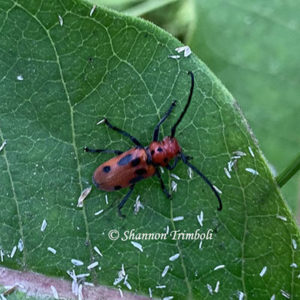
Also in mid-June, the Forest Health Specialist from the Kentucky Division of Forestry visited our property to look for laurel wilt disease and set up a couple of monitoring stations. We had one slightly suspicious sassafras (not my big tree) that may be in the extremely early stages. I’m keeping a close eye on it, but so far things are looking positive for it. If you don’t know about laurel wilt disease, please listen to the recent Backyard Ecology podcast episode on this disease.
All kinds of cool flowers and plants have bloomed over the last month or two. Most of our milkweeds bloomed in June which gave me the opportunity to watch lots of interesting insects. It never ceases to amaze me how many different types of insects are attracted to milkweeds. Our smooth sumac also bloomed at the end of June, just in time for National Pollinator Week. The blooms didn’t last long, but the flowers were absolutely a buzz with activity before being replaced by bright red berries. I have a short video on Facebook of several species of bees working one of our smooth sumac flowerheads. All the different flowers in bloom also means lots and lots of butterflies of many species. I never get tired of watching all the different bees and butterflies.
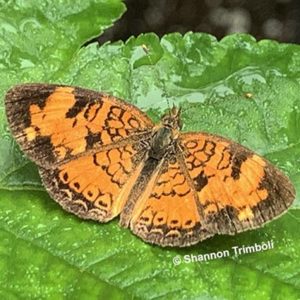
A few weeks ago, I was walking through the yard with my camera and heard a really loud buzzing. I’ve learned that loud buzzing often means fly, not bee. I quickly turned and spotted the robber fly pictured below landing with its prey – a Japanese beetle. Yes, that’s a fly, not a bee. Note the short antennae and big, fly-like eyes. Adult robber flies prey upon a variety of flying insects, usually catching them in mid-air then landing nearby to suck out their insides. I was super excited to see this one, not only because it had caught a Japanese beetle (Yay! One less Japanese beetle in my yard.), but also because I don’t see the bee mimics as often as I see some of the other robber flies.
Besides the lightning bugs, bees, and butterflies, another one of my favorite summertime insects is the antlion. Every summer the dry, sandy floor on either end of our barn is covered in conical pits made by antlion larvae. Antlion larvae, also called doodlebugs, have always fascinated me. The larvae will create the pits, then wiggle into the dirt to hide near the bottom of the pit. When an unsuspecting ant or other insect slips into the pit and slides towards the bottom, the antlion larvae will pounce and grab the ant with its long, pincer like mandibles. You can also sometimes trick it by gently rubbing a small piece of grass along the inside of the pit to mimic an ant sliding into the pit. That’s what I did to get the photograph of the exposed antlion larvae.
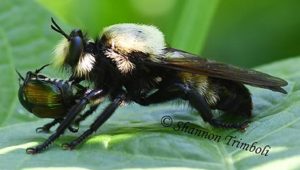
Oh, and I have to share one more of my recent nature-related discoveries. The other day I found the most amazing little red jewels glued to the top of one of my hairy mountain mint leaves. They are some kind of “bug” egg. Based on internet searches, I’m pretty sure they are leaf-footed bug eggs. I just thought the eggs were absolutely gorgeous and well worth sharing.
So, what interesting nature-related discoveries have you made in your yard and community over the last few weeks? I always enjoy hearing what others are finding too.
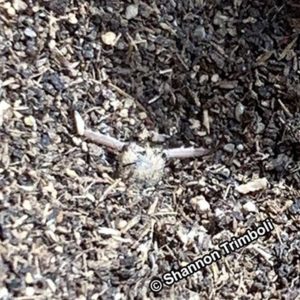
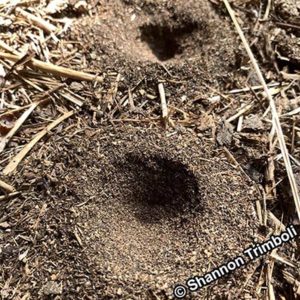
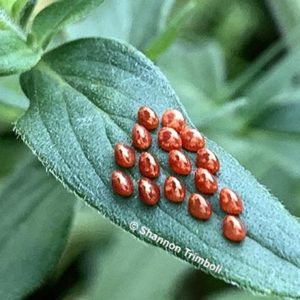

Backyard Ecology: Exploring Nature in Your Backyard
Nature isn’t just “out there.” It’s all around us, including right outside our doors. Hi, my name is Shannon Trimboli, and I am the host of Backyard Ecology. I live in southcentral Kentucky and am a wildlife biologist, educator, author, beekeeper, and owner of a nursery specializing in plants for pollinators and wildlife conservation. I invite you to join me as we ignite our curiosity and natural wonder, explore our yards and communities, and improve our local pollinator and wildlife habitat. Learn more or subscribe to my email list at www.backyardecology.net.

Leave a Reply